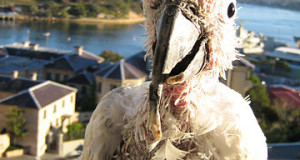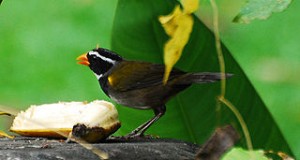The Parakeet, Budgerigar or “Budgie”, Melopsittacus undulatus, arrived on the European pet scene in 1840 and has since become one of the world’s most popular pets. However, perhaps because they are small and inexpensive, Budgies are sometimes not viewed as “real parrots” by their owners, and consequently are not given the chance to show off their many talents. In addition to being wonderful mimics, Budgies can learn a great variety of tricks…and seem to take pleasure in doing so!
Trust
Getting your pet to accept your presence, and then to be comfortable with your hand in its vicinity, is an essential first step in training. This is generally quite simple, as budgies are sociable by nature and rather miserable without human or avian company. Please see this article for more on basic care and creating trust.
Target Training
Originally designed for use with captive marine mammals, target training is a concept that has been successful with a variety of birds, mammals and even reptiles. During my years working for the Bronx Zoo, target training lessened the stress (on me and my charges!) of working closely with animals ranging from elephants to eagles. Basically, a target-trained animal will position its head (or other body part) next to a target when it is presented.
Parakeets take readily to target training; once this is mastered it will be easier for them to learn more complicated tricks. While it is not essential to begin with target training, I definitely recommend doing so rather than trying to jump straight into more difficult lessons.
A perch, branch or chopstick will serve well as your bird’s target. First show your pet the target through the bars of the cage without approaching or forcing contact. Eventually begin to move the target towards the bird…most individuals will explore the new object with their beaks. Once contact is made with the target, reward your pet with a treat. Continue to do this until the Budgie moves quickly toward the target each time it is presented. Try placing the target some distance from the bird to see if she or he recognizes it in new locations, and continue with rewards.
Eventually you can situate the target so that the Budgie must walk over, and then onto, your finger in order to reach it. This is an important milestone, and signals that your pet is ready to learn new behaviors, such as twirling around or pushing a ball. I’ll cover such tricks in the future; until then, please write in for details.
Training Guidelines
When training any animal, it is important that you are familiar with its individual personality. Parakeets are easily stressed by overly-enthusiastic owners, and will refuse contact if this happens. Never push your bird to learn, and keep in mind that on some days it will just not respond to training at all.
The length of your training sessions should be tailored to the individual bird, but 5-15 minutes is a typical “attention span”. Repetition is important, but only when the bird is ready. Withholding treats or scolding of any kind is pointless where birds are concerned, and will set back any progress that has been made.
Clicker Training
It is often useful to use sound to reinforce what your bird has learned. Simple clickers (please see photo) are employed in zoos and circuses to signal “job well done”.
 To use this technique, simply press your clicker (be sure the bird is familiar with the sound beforehand) each time the Budgie touches its target or otherwise does as you wish, and then provide a treat. Eventually, the sound of the clicker may stimulate the bird to perform…be sure to reward your pet as well.
To use this technique, simply press your clicker (be sure the bird is familiar with the sound beforehand) each time the Budgie touches its target or otherwise does as you wish, and then provide a treat. Eventually, the sound of the clicker may stimulate the bird to perform…be sure to reward your pet as well.
Further Reading
Budgie Care and Natural History
Research Paper: Problem Solving Abilities of Budgies and other Parrots
 That Bird Blog – Bird Care and History for Pet Birds
That Bird Blog – Bird Care and History for Pet Birds




hello Frank,
recently i went to my local bird store, and i saw a cute young budgie, still with mottled beak and head full of stripes. as i poke my finger onto the cage bar, instead of running away it came closer and nibbled my finger, its as if it wants me to adopt it!
so i was thinking of getting this young bird someday, get its flight feathers clipped properly, and if i had free time i would let my canary watch how a tame bird should behave and to trust me…
what do you think about it? would it work?
and as you know, my canary is “quite” tame already
also, can a budgie and canary live together in a spacious aviary?
thanks
Hello Raymond, Frank Indiviglio here.
Nice to hear from you again. Picking a bird that is already socialized and curious is the best way to go. Birds can learn behaviors from one another – .i.e. after watching others solve a problem to get a reward, others that are new to the task will apply what they’ve seen and avoid pitfalls (fish, tortoises, many others as well). I’ve not seen anything that would indicate a transfer of more complex ideas, such as trust etc., but definitely worth a try (decades ago we tried showing films of gorillas nursing their young to females that lacked mothering skills…they seemed to enjoy the show, but didn’t learn anything!).
People have kept budgies with canaries, but it’s often difficult. Assuming they did get along, the budgie would be constantly preening the canary, seeking close contact, and so on, which is not in the canary’s nature. Also, making sure each received a proper diet might be difficult, hard to monitor who is eating what, given their different needs.
Please let me know if you need any further information. Good luck, enjoy and please keep me posted.
Best regards, Frank Indiviglio.